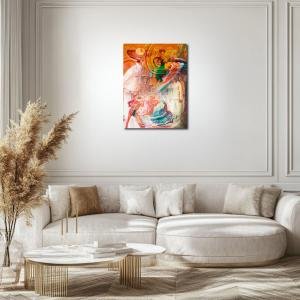Reflections of Dual Realities: Monet’s Grenouillère in a Surreal Depth
"Reflections of Dual Realities" reimagines Claude Monet’s Bain à la Grenouillère with surrealist depth. The lively café scene, illuminated by a glowing moon, contrasts with an enigmatic underwater world where an elephant cradles another moon. This layered composition explores dualities—surface and depth, reality and imagination—while celebrating Monet’s mastery of light and movement. The warm, joyful tones above mirror the serene mystery below, inviting viewers to reflect on the unseen dimensions of life and the interconnectedness of all things. It is a poetic meditation on beauty, memory, and the hidden depths of existence.
Please see Below for Details…
Hotline Order:
Mon - Fri: 07AM - 06PM
404-872-4663
Claude Monet’s Bain à la Grenouillère (1869), housed at the Metropolitan Museum of Art, is a quintessential Impressionist painting that captures the leisurely summer atmosphere of a popular floating café and bathing spot on the Seine. This serene and joyous depiction of light, water, and social life has been transformed in the surrealist reinterpretation titled "Reflections of Dual Realities." Here, Monet’s bright, airy depiction of Grenouillère meets a dreamlike underwater world, creating a poetic meditation on dualities—surface and depth, reality and imagination, past and present.
The original painting, created during Monet’s pivotal stay in Bougival alongside Pierre-Auguste Renoir, is celebrated for its loose brushwork and vibrant play of light on water. Monet’s technique focused on capturing the transient effects of light and movement, portraying the Seine’s shimmering reflections, the floating bathhouses, and the lively interactions of people enjoying leisure time. His palette of soft greens, blues, and warm yellows reflects a scene bathed in sunlight, evoking a sense of harmony and the carefree spirit of mid-19th-century France.
In this surreal reinterpretation, the upper half retains the essence of Monet’s Grenouillère, depicting the lively café and idyllic water reflections under a glowing full moon. However, the scene takes an unexpected turn below the surface, where an elephant submerged underwater holds a smaller, illuminated moon. The juxtaposition of these two worlds—one airy and bustling, the other deep and mysterious—creates a dialogue about unseen realities and the depths of the human experience.
The moon, both above and below, serves as a central symbolic element. In the sky, it illuminates the nocturnal beauty of Grenouillère, casting a dreamlike glow over the figures and their reflections. Underwater, the moon’s presence becomes enigmatic, held delicately by the elephant—a creature often associated with wisdom, memory, and endurance. This underwater scene suggests a hidden, surreal dimension to the otherwise lively surface world, encouraging viewers to ponder what lies beneath the seemingly mundane.
The choice of color in this reinterpretation enhances its emotional and symbolic resonance. The warm yellows and greens in the upper half evoke familiarity, joy, and community, echoing the social pleasures Monet originally captured. In contrast, the cooler blues and silvery tones of the underwater world introduce a sense of wonder, mystery, and introspection. The interplay of light and shadow between these two realms reinforces the duality of existence—how beauty and complexity coexist above and below the surface.
As an artist, this reinterpretation was inspired by Monet’s ability to capture fleeting moments of light and atmosphere, as well as by a desire to delve deeper into the subconscious and symbolic potential of his work. The addition of surrealist elements, such as the elephant and the submerged moon, transforms Grenouillère into a space where dreams and reality intersect. The elephant’s presence serves as a metaphor for memory and depth, reminding us that beneath every vibrant surface lies an unseen story waiting to be uncovered.
This artwork also explores themes of interconnectedness. The moon, present in both realms, ties the surface world to the underwater one, suggesting that our lives are influenced by forces we cannot always see or comprehend. The mirrored scenes reflect the duality of human existence—our external lives filled with activity and interaction, and our internal worlds rich with emotion, memory, and imagination.
Monet’s Bain à la Grenouillère is special for its role in the development of Impressionism, marking a shift away from traditional academic painting toward a focus on light, movement, and the everyday. This surreal reinterpretation builds on that legacy, expanding the boundaries of the scene to explore the subconscious and the fantastical. By blending the airy joy of Impressionism with the introspection of surrealism, this piece invites viewers to reflect on the layers of reality and the hidden depths within themselves.
"Reflections of Dual Realities" is both a tribute to Monet’s groundbreaking vision and an exploration of the timeless questions his work inspires. By combining his Impressionist ethos with surrealist imagery, this reinterpretation bridges the gap between external beauty and internal complexity, offering a visual journey through light, shadow, and the mysteries beneath the surface.
Add your review
Your email address will not be published. Required fields are marked *
Please login to write review!
Looks like there are no reviews yet.








